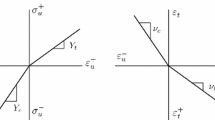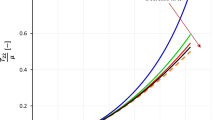Abstract
Hyperelastic materials have high deformability and nonlinearity in load–deformation behavior. Based on a phenomenological approach, these materials are treated as a continuum, and a strain energy density is considered to describe their hyperelastic behavior. In this paper, the mechanical behavior characterization of these materials is studied from the continuum viewpoint. For this purpose, the strain energy density is expressed as sum of independent functions of the mutual multiple of principal stretches. These functions are determined by applying the governing postulates on the form of the strain energy density. It is observed that a consistent strain energy density is expressible in terms of the mathematical functions of polynomial, power law, logarithmic and particularly exponential. The proposed strain energy density functions cover modeling both of compressible and incompressible materials. Moreover, the material parameters of these models are calculated based on the correlation between the values of the strain energy density (rather than the stresses) cast from the test data and the theory. In order to investigate the appropriateness of the proposed models, several experimental data for incompressible and compressible isotropic materials under homogeneous deformations are examined in which the predictions of the proposed models show a good agreement with experimental data.
Similar content being viewed by others
References
Rivlin R.S., Saunders D.W.: Large elastic deformations of isotropic materials VII, experiments on the deformation of rubber. Phil. Trans. R. Soc. A 243, 251–288 (1951)
Valanis K.C., Landel R.F.: The strain-energy function of hyper-elastic material in terms of extension ratios. J. Appl. Phys. 38, 2997–3002 (1967)
Ogden R.W.: Biaxial deformation of rubber-like solids: comparison of theory and experiment. J. Phys. D: Appl. Phys. 12, 1463–1472 (1979)
Kakavas P.A.: A new development of the strain energy function for hyperelastic materials using a logarithmic strain approach. J. Appl. Poly. Sci. 77, 660–672 (2000)
Attard M.M.: Finite strain isotropic hyperelasticity. Int. J. Solids Struct. 40, 4353–4378 (2003)
Beatty M.F.: Topics in finite elasticity: hyperelasticity of rubber, elastomers and biological tissues with examples. Appl. Mech. Rev. 40, 1699–1734 (1987)
Ehlers W., Eipper G.: The simple tension problem at large volumetric strains computed from finite hyperelastic material laws. Acta Mech. 130, 17–27 (1998)
Yeoh O.H.: Characterization of elastic properties of carbon black filled rubber vulcanizates. Rubber Chem. Technol. 63, 792–805 (1990)
Yeoh O.H.: Some forms of the strain energy function for rubber. Rubber Chem. Technol. 66, 754–771 (1993)
Lambert-Diani J., Rey C.: New phenomenological behavior laws for rubbers and thermoplastic elastomers. Eur. J. Mech. A/Solids 18, 1027–1043 (1999)
El-Lawindy A.M.Y., El-Guiziri S.B.: Strain energy density of carbon-black-loaded rubber vulcanizates. J. Phys. D: Appl. Phys. 33, 1894–1901 (2000)
Boyce M.C., Arruda E.M.: Constitutive models of rubber elasticity. Rubber Chem. Technol. 73, 504–523 (2000)
Bradley G.L., Chang P.C., Mckenna G.B.: Rubber modeling using uniaxial test data. J. Appl. Poly. Sci. 81, 837–848 (2001)
Bischoff J.E., Arruda E.M., Grosh K.: A new constitutive model for the compressibility of elastomers at finite deformations. Rubber Chem. Technol. 74, 541–559 (2000)
Ogden R.W.: Non-Linear Elastic Deformations. Dover Publications, Mineola (1997)
Treloar L.R.G.: The Physics of Rubber Elasticity. Clarendon Press, Oxford (1975)
Drozdov A.D.: Constitutive equations in finite elasticity of rubbers. Int. J. Solids Struct. 44, 272–297 (2007)
Ogden R.W., Saccomandi G., Sgura I.: Fitting hyperelastic models to experimental data. Comput. Mech. 34, 484–502 (2004)
Hartmann S.: Numerical studies on the identification of the material parameters of Rivlin’s hyperelasticity using tension-torsion tests. Acta Mech. 148, 129–155 (2001)
Gendy A.S., Saleeb A.F.: Nonlinear material parameter estimation of characterizing hyperelastic large strain models. Comput. Mech. 25, 66–77 (2000)
Treloar L.R.G.: Stress–strain data for vulcanised rubber under various types of deformation. Trans. Faraday Soc. 40, 59–70 (1944)
Kawabata S., Matsuda M., Tel K., Kawai H.: Experimental survey of the strain energy density function of isoprene rubber vulcanizate. Macromolecules 14, 154–162 (1981)
Heuillet, P., Dugautier, L.: Modelisation du comportement hyperelastique des caoutchoucs et elastomeres thermoplastiques, compacts on cellulaires. Genie Mecanique des Caoutchoucs et des Elastomeres Thermoplastiques (1997)
Alexander H.: A constitutive relation for rubber-like materials. Int. J. Eng. Sci. 9, 549–563 (1968)
Bridgman P.W.: The pressure–volume–temperature relations of fifteen liquids. Proc. Am. Acad. Arts Sci. 68, 1–25 (1933)
Bridgman P.W.: Electrical resistances and volume changes up to 20,000 kg/cm2. Proc. Natl. Acad. Sci. 21, 109 (1935)
Adams L.H., Gibson R.E.: The compressibility of rubber. J. Acad. Sci. 20, 213–223 (1930)
Bridgman P.W.: The compression of 61 substances to 25,000 kg/cm2 determined by a new rapid method. Proc. Am. Acad. Arts Sci. 76, 9–24 (1945)
Penn R.W.: Volume changes accompanying the extension of rubber. Trans. Soc. Rheo. 14, 509–517 (1970)
Author information
Authors and Affiliations
Corresponding author
Rights and permissions
About this article
Cite this article
Darijani, H., Naghdabadi, R. Hyperelastic materials behavior modeling using consistent strain energy density functions. Acta Mech 213, 235–254 (2010). https://doi.org/10.1007/s00707-009-0239-3
Received:
Revised:
Published:
Issue Date:
DOI: https://doi.org/10.1007/s00707-009-0239-3




